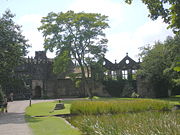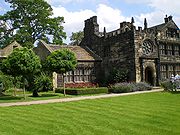
East Riddlesden Hall
Encyclopedia


Manor house
A manor house is a country house that historically formed the administrative centre of a manor, the lowest unit of territorial organisation in the feudal system in Europe. The term is applied to country houses that belonged to the gentry and other grand stately homes...
in Keighley
Keighley
Keighley is a town and civil parish within the metropolitan borough of the City of Bradford in West Yorkshire, England. It is situated northwest of Bradford and is at the confluence of the River Aire and the River Worth...
, West Yorkshire
West Yorkshire
West Yorkshire is a metropolitan county within the Yorkshire and the Humber region of England with a population of 2.2 million. West Yorkshire came into existence as a metropolitan county in 1974 after the passage of the Local Government Act 1972....
, now owned by the National Trust
National Trust for Places of Historic Interest or Natural Beauty
The National Trust for Places of Historic Interest or Natural Beauty, usually known as the National Trust, is a conservation organisation in England, Wales and Northern Ireland...
. The hall was built in 1642 by a wealthy Halifax
Halifax, West Yorkshire
Halifax is a minster town, within the Metropolitan Borough of Calderdale in West Yorkshire, England. It has an urban area population of 82,056 in the 2001 Census. It is well-known as a centre of England's woollen manufacture from the 15th century onward, originally dealing through the Halifax Piece...
clothier, James Murgatroyd. There is a medieval tithebarn in the grounds.
East Riddlesden Hall perches on a small plateau overlooking a bend in the River Aire
River Aire
The River Aire is a major river in Yorkshire, England of length . Part of the river is canalised, and is known as the Aire and Calder Navigation....
on its way downstream from the town of Keighley
Keighley
Keighley is a town and civil parish within the metropolitan borough of the City of Bradford in West Yorkshire, England. It is situated northwest of Bradford and is at the confluence of the River Aire and the River Worth...
. Interesting features include well-restored living accommodation on two floors, two Yorkshire
White Rose of York
The White Rose of York , a white heraldic rose, is the symbol of the House of York and has since been adopted as a symbol of Yorkshire as a whole.-History:...
Rose windows, walled garden, the ruined Starkie wing and several ghosts (reputedly). A hiding place
Priest hole
"Priest hole" is the term given to hiding places for priests built into many of the principal Catholic houses of England during the period when Catholics were persecuted by law in England, from the beginning of the reign of Queen Elizabeth I in 1558....
for Catholic priests was installed during the 16th century.
The property was extended and re-built by James Murgatroyd and his wife Hannah, using local Yorkshire stone, in 1648. He also built other stone manor houses throughout the West Riding of Yorkshire
West Riding of Yorkshire
The West Riding of Yorkshire is one of the three historic subdivisions of Yorkshire, England. From 1889 to 1974 the administrative county, County of York, West Riding , was based closely on the historic boundaries...
. In the great hall
Great hall
A great hall is the main room of a royal palace, nobleman's castle or a large manor house in the Middle Ages, and in the country houses of the 16th and early 17th centuries. At that time the word great simply meant big, and had not acquired its modern connotations of excellence...
, a small fireplace can be seen above the main fire place, where the floor for the first floor accommodation was not built. James Murgatroyd was a Royalist
Cavalier
Cavalier was the name used by Parliamentarians for a Royalist supporter of King Charles I and son Charles II during the English Civil War, the Interregnum, and the Restoration...
and this can be seen in royalist symbols and graffiti on and in the building. For example, the Bothy (now the tea room and shop) has the heads of Charles I of England
Charles I of England
Charles I was King of England, King of Scotland, and King of Ireland from 27 March 1625 until his execution in 1649. Charles engaged in a struggle for power with the Parliament of England, attempting to obtain royal revenue whilst Parliament sought to curb his Royal prerogative which Charles...
and Henrietta Maria of France
Henrietta Maria of France
Henrietta Maria of France ; was the Queen consort of England, Scotland and Ireland as the wife of King Charles I...
carved in the top most stone work.
According to a NODA National News feature in 2007, the Murgatroyd family are reputed to be the inspiration for the Murgatroyd Baronet
Baronet
A baronet or the rare female equivalent, a baronetess , is the holder of a hereditary baronetcy awarded by the British Crown...
s in the comic opera
Comic opera
Comic opera denotes a sung dramatic work of a light or comic nature, usually with a happy ending.Forms of comic opera first developed in late 17th-century Italy. By the 1730s, a new operatic genre, opera buffa, emerged as an alternative to opera seria...
Ruddigore
Ruddigore
Ruddigore; or, The Witch's Curse, originally called Ruddygore, is a comic opera in two acts, with music by Arthur Sullivan and libretto by W. S. Gilbert. It is one of the Savoy Operas and the tenth of fourteen comic operas written together by Gilbert and Sullivan...
by Gilbert and Sullivan
Gilbert and Sullivan
Gilbert and Sullivan refers to the Victorian-era theatrical partnership of the librettist W. S. Gilbert and the composer Arthur Sullivan . The two men collaborated on fourteen comic operas between 1871 and 1896, of which H.M.S...
, and the opera has been performed at the Hall. W. S. Gilbert
W. S. Gilbert
Sir William Schwenck Gilbert was an English dramatist, librettist, poet and illustrator best known for his fourteen comic operas produced in collaboration with the composer Sir Arthur Sullivan, of which the most famous include H.M.S...
is supposed to have stayed often at the Hall. The feature comments that the Murgatroyds became notorious "for their profanity and debauchery, and members of the family were fined, imprisoned and excommunicated". It asserts that the character of Sir Despard Murgatroyd in Ruddigore is based on James Murgatroyd.
Filming location
East Riddlesden Hall has been used as a filming locationFilming location
A filming location is a place where some or all of a film or television series is produced, in addition to or instead of using sets constructed on a movie studio backlot or soundstage...
for the 1992 film Emily Brontë's Wuthering Heights
Emily Brontë's Wuthering Heights
Emily Brontë's Wuthering Heights was a 1992 feature film adaptation of Emily Brontë's novel Wuthering Heights directed by Peter Kosminsky....
and for the 2009 TV adaptation. It was also used in Sharpe's Justice
Sharpe's Justice
Sharpe's Justice is a British television drama, part of a series that follows the career of Richard Sharpe, a British soldier during the Napoleonic Wars. Unlike most of the other installments of the series, this episode was not based on a novel by Bernard Cornwell...
episode from the Sharpe TV series
Sharpe (TV series)
Sharpe is a British series of television dramas starring Sean Bean about Richard Sharpe, a fictional British soldier in the Napoleonic Wars. Sharpe is the hero of a number of novels by Bernard Cornwell; most, though not all, of the episodes are based on the books...
in 1997. It also featured in series eight of the paranormal television
Paranormal television
Paranormal television is a genre of popular reality television programming. Its scope comprises purportedly factual investigations of paranormal phenomena, rather than fictional representations found in such shows as The Ghosts of Motley Hall and Ghostbusters, or cartoon/children's series such as...
programme Most Haunted
Most Haunted
Most Haunted is a British paranormal documentary reality television series. The series was first shown on 25 May 2002 and ended on 21 July 2010. It was broadcast on Living and presented by Yvette Fielding. The programme was based on investigating purported paranormal activity...
.

